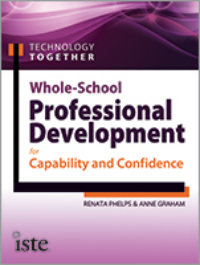Technology Together: Whole-School Professional Development
Technology Together: Whole-School Professional Development for Capability and Confidence
By Renata Phelps and Anne Graham
(International Society for Technology in Education, 2013 – Learn more)

Technology Together is a book describing a professional development process for K-12 schools that focuses both on whole school and individual teacher change. The motto of Technology Together is “I Can-You Can,” which sums up the philosophy of teachers supporting each other to move forward with technology learning and implementation in the school community.
One of the things that is refreshing about Technology Together: Whole-School Professional Development for Capability and Confidence is that it describes a flexible implementation process. The process is based on a philosophy of professional learning that underscores the development of attitudes, values and beliefs that promote confidence and openness. Ideally, under such conditions, teachers are able to adapt to change and are enthusiastic about ongoing learning.
 The research behind the book
The research behind the book
Authors Renata Phelps and Anne Graham (both PhD’s) are affiliated with Southern Cross University in Australia and have research interests in the area of teacher development. Phelps is specifically interested in educational informational technology and the integration in K-12 and post-secondary educational environments.
Using action research cycles over the course of several years, the authors developed a metacognitive approach to technology learning for use in teacher education programs. Their approach supported individuals in developing confidence in their own technology learning and implementation strategies.
An area school system was used to pilot Technology Together in partnership with Southern Cross University. Additional research about how school communities can best encourage and support teachers in learning technology, from each other and from their students, was compiled and synthesized.
Technology Together is based on six principles: Prioritizing whole-school development, creating a climate for learning, acknowledging and accepting change, increasing teachers’ confidence and motivation to use technology, emphasizing immediate learning outcomes for students, and enhancing teachers’ professionalism.
The challenges schools and educators face
With new apps being unveiled every day, it is difficult for any teacher to keep up. Consider the teacher who has always been a leader in the school – an expert in pedagogy that others have always looked up to. Although not an early adopter of technology, this master teacher was initially enthusiastic about some of the tools that would facilitate teaching and student learning. Over time, however ,this teacher increasingly felt out-paced by the rapid rate of innovation and began to withdraw from new opportunities.
Within a year, this teacher felt so demoralized by what he referred to as an “unrelenting bombardment” that he felt completely helpless. Now consider another teacher who is known to be an innovator. She can’t wait to try the next new thing, and seems to have an app for everything, both professionally and personally. How do we bridge the gap between the two?
Quite telling is a quote the book provides from one Technology Together participant:
Generally, teachers observe others with computer skills and think that they somehow attained the skills by magic. They think that they deserve the same dose of magic. They need to be convinced that they can get there if they approach the situation with a positive attitude.”
This is a very real problem, and school administrators and technology leaders often don’t know how to bridge the learning gaps or repair a school climate that becomes fractured due to impatience and animosity that arises between the “tech natives,” the “tech innovators” and the “old-schoolers.”
The strategies in more detail
Technology Together provides strategies to empower staff to become confident risk-takers. These strategies grow out of the idea that, in the world of technology, the people who seem “out in front” are the ones who are most comfortable in engaging with the unknown or untried. They may not be any smarter than the rest, but what they possess is confidence – and that confidence increases as they expand their own capabilities.
The book is divided into seven chapters. The first two chapters provide a foundation for understanding why a whole-school approach is important, the theoretical foundations of the approach, and an overview of the eight foundational pillars.
When you’re ready to really dig in, Chapter 3 provides almost 40 pages of guidance related to planning, including introducing Technology Together to your school, allocating roles, developing an analysis and determining goals, planning mentoring strategies, providing time and opportunities for staff reflection and discussion, and showcasing and celebrating achievements.
The chapter that most interested me was Chapter 4, “Mentoring within a Metacognitive Framework.” Mentoring in a Technology Together context is definitely different from traditional coaching or mentoring. Even if a school doesn’t choose to use the entire Technology Together approach, this chapter speaks volumes about how technology mentoring looks and feels different, as its purpose is to not simply build competency, but more importantly, capability. It is about building capacity for transferability.
The book can be used concurrently with the Technology Together website which has a participants’ zone with many useful resources. Dr. Phelps also has a Technology Together Facebook site and Twitter feed.
A terrific resource
This is a great read and a terrific resource for school & district technology and administrative leaders, as well as central office curriculum and professional development staff. The book offers a mix of theory and suggestions for taking action. It provides checklists, job description and survey examples. It is practical and useful!
We know technology innovation will be continual and fast-paced. Building confidence in individual teachers and a culture of collegiality and sharing in a whole school will help overcome reluctance and resistance and move everyone forward in their learning and tech implementation.
Marilyn King, Ed.D., is the Deputy Superintendent Instruction for the Bozeman Public Schools. She has administrative experience at the elementary and middle school levels as well as K-12 teaching experience. Her professional interests include impacts of instructional leadership on student achievement, change processes in education and consensus.































